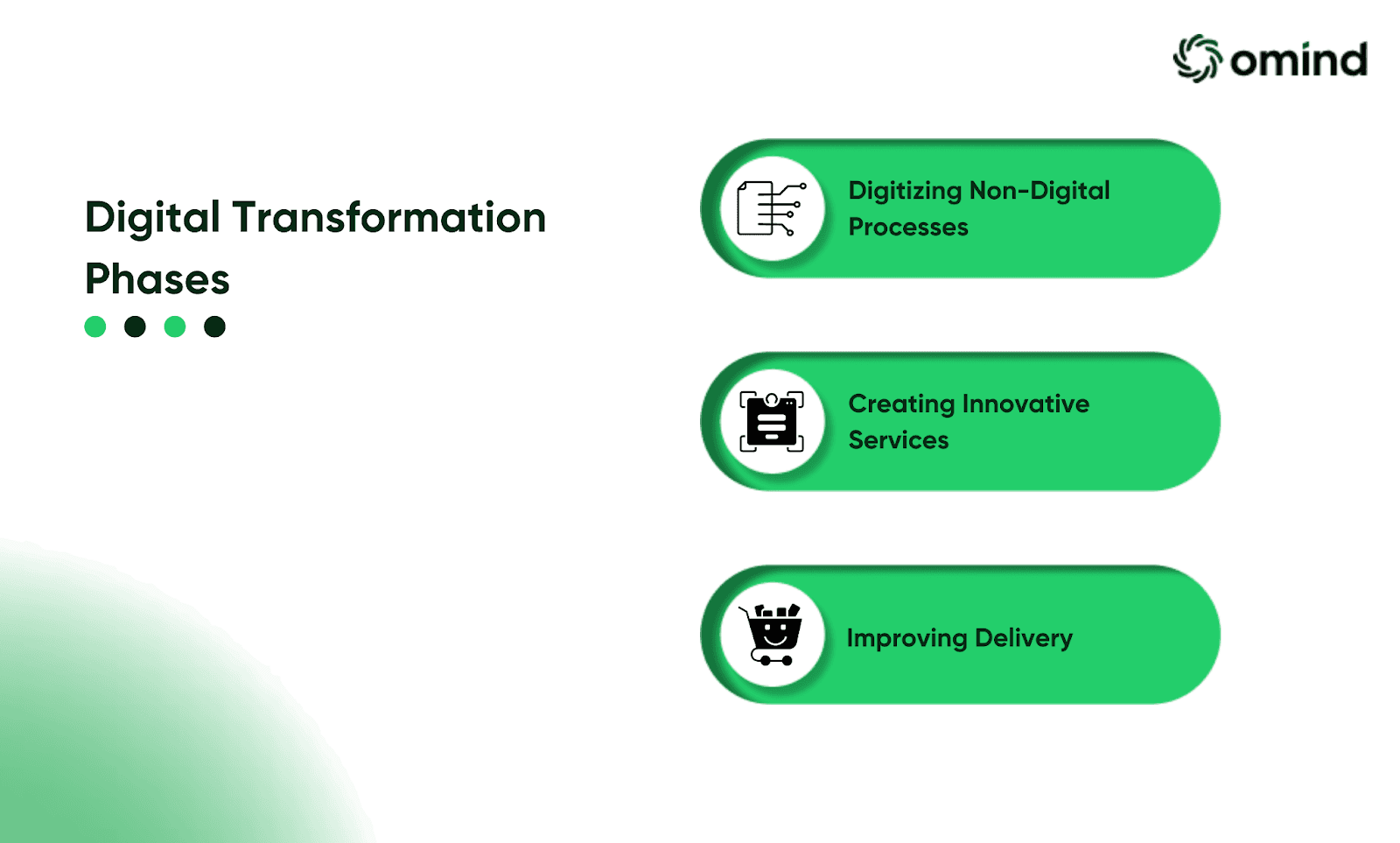The challenge for many businesses in the current era is not just adopting the latest technology that’s available to them, but fundamentally reshaping their strategies and processes to stay relevant. The digital transformation sphere is expected to grow to a record $1008 billion by the year 2025, which means that businesses are definitely looking to enact it in their operations, and quickly. Market pressure is definitely one reason businesses are looking to shift as well.
If you're looking to unlock the full potential of digital transformation for your organization, read on to discover a few effective strategies that can lead to sustained innovation and growth. You'll also learn about the key areas of transformation, the importance of managing change effectively, and how to overcome common challenges like resistance to change within the organization.
What Is Digital Transformation?

To put it simply, digital transformation is an operational shift that integrates digital technology into a company's operations to fundamentally alter its business model, culture, and customer experience. With the help of these technologies, organizations can adapt to rapidly changing market conditions and improve themselves.
At the core of managing digital transformation is the reimagining of most of the traditional business processes, which is a journey of several phases. Let’s go through each one.
Digitizing Non-Digital Processes: By transitioning from manual or paper-based processes to digital workflows, organizations can reduce errors, improve accuracy, and increase efficiency.
Creating Innovative Services: Digital technologies enable the development of new products and services that were previously unattainable. For example, companies can offer personalized experiences, real-time data insights, and on-demand services.
Improving Delivery: Digital tools can optimize supply chains, logistics, and customer support, leading to faster delivery times, improved customer satisfaction, and reduced costs.
Adapting Business Models for a Digital Future
A good sign of successful digital transformation is the ability to continuously adapt business models to meet evolving market needs. As digital technologies advance, companies must find innovative ways to deliver value and stay relevant in their industries.
For instance, in the automotive sector, there's a growing trend towards subscription-based services, such as car sharing and subscription-based vehicle ownership. These models, combined with automated billing processes, offer consumers flexibility and convenience while unlocking new revenue streams for businesses. It’s crucial to adapt to agile and experimental corporate culture for managing digital transformation. Companies that embrace practices like Agile workflow, or DevOps, can quickly build and expand on their products and services which allows them to quickly respond to a market of change.
Key Areas of Digital Transformation in Enterprises
Businesses that want to undergo a digital transformation typically undergo change in three pivotal areas: enhancing customer experience, improving operational processes, and innovating business models.
Personalized Experiences: Modern analytics models enable companies to collect and analyze customer data, gaining valuable insights into preferences, behaviors, and needs. This information can then be used to deliver highly personalized content, recommendations, and offers, creating a more tailored and engaging customer experience.
Real-time Personalization: AI and machine learning algorithms can analyze customer behavior in real time, providing dynamic suggestions and recommendations that are relevant to the current context. This enables businesses to offer personalized experiences that adapt to individual preferences.
Omnichannel Strategy: An omnichannel approach ensures a consistent customer experience across all channels, including websites, mobile apps, social media, and physical stores. Omnichannel experiences allow customers to engage with businesses on their preferred platform and especially across multiple platforms, accessing information and services whenever they need them.
Tools and Strategies for Effective Transformation

When managing digital transformation, having the right tools and strategies is essential for guiding an organization through change effectively. Let’s go through some of these now.
The power of AI: AI platforms, such as those provided by Omind, can significantly enhance role adaptation through an integration of project and change management. AI platforms analyze data to provide role-specific recommendations and training programs, using intelligent simulations to model different strategic scenarios.
Automate (almost) everything: Automation tools, such as Robotic Process Automation (RPA) software, can significantly improve productivity. RPA software automates repetitive, rule-based tasks, freeing up human employees to focus on more strategic and complex work.
Get security: Cybersecurity solutions, including firewalls, intrusion detection systems, and data encryption tools, are essential for protecting sensitive data and systems from unauthorized access and malicious attacks.
Listen to the customer: A customer-centric approach focuses on understanding customer needs and delivering exceptional experiences. By gathering customer feedback, analyzing customer data, and tailoring products and services to meet customer expectations, organizations can build strong relationships with their customers, increase customer loyalty, and drive business growth.
Employee engagement: By now, it can be understood that this is a non-negotiable during managing digital transformation. With chatbots and virtual assistants, employees receive personalized support, improving their engagement levels. Machine learning and natural language processing can also play a crucial role in refining internal and external communications.
Importance of Change Management

Change management serves as a bridge between innovative tech solutions and their effective implementation. It ensures that employees are equipped with the necessary skills, knowledge, and support to adapt to new ways of working. Organizations that fail to invest in change management risk seeing their technology investments go to waste, as employees may resist or struggle to adopt new tools and processes. So it’s important that organizations must create a supportive environment where employees understand the importance of embracing change, and also allow teams to experiment with new ideas (even if all of them don’t work) and contribute to the digital transformation process.
Steps for Successful Digital Transformation Management
Embarking on a digital transformation journey requires a strategic approach to manage changes effectively. Let’s look at these steps in some detail now.
Prepare for Change: Create detailed transformation charters. Establish a clear vision and communicate it to all stakeholders. Emphasize expected transformation outcomes.
Define Transformation Goals: Identify specific business objectives. Align goals with broader organizational objectives.
Develop Processes: Align processes with new digital capabilities. Understand emerging technologies and their potential. Create new processes to support these technologies. Engage employees early in the process.
Train and Develop: Provide comprehensive training programs. Equip employees with necessary skills and knowledge.
Monitor and Evaluate: Conduct regular checkpoints and feedback loops. Engage with stakeholders through feedback sessions and meetings. Promote agility and adaptability.
Securing the fort: According to a report by RSM Canada, cybersecurity is a growing concern in digital transformation, with 28% of organizations reporting a security breach in 2024. Therefore, it's also essential to incorporate security measures in your transformation strategy to protect organizational data and systems.
It’s also vital that organizations measure the success of their digital transformation operations. Using metrics like ROI and productivity KPIs to evaluate the impact, while laborious, can be fruitful for the long term. It helps to establish clear frameworks that combine short-term metrics with long-term perspectives, including both numbers and qualitative insights.
Challenges in Digital Transformation
One of the primary challenges in digital transformation is the misconception that it's solely about technology. While technology does sit at the core of digital transformation, there are layers to it: Many organizations focus on simply adopting new tools without considering how these changes impact their core business models and operations. This approach can hinder progress, as it fails to fully realize the potential benefits of digital transformation.
Another significant obstacle is cultural resistance to change. A McKinsey report states that over 70% of digital transformation strategies fail because of resistance from within the organization. Employees and leaders may be reluctant to adopt new ways of working due to comfort with established methods or fear of disrupting something that, at least from the outsider, appears to be already functioning well.
Nurturing a Culture of Continuous Digital Innovation
The World Economic Forum's Future of Jobs 2023 report highlights that 44% of core skills will be disrupted in the next four years. For digital transformation to take root, organizations should strongly be ready to move away from rigid hierarchical structures and adopt collaborative systems that encourage learning and adaptability. Phased adoption can ease transitions and minimize resistance, aligning technological advancement while enhancing the investment both financially and in terms of hours spent.
AUTHOR
Team Omind
Empowering Businesses with Unified Customer Experience Platform, Leveraging Advanced AI and Intelligent Automation.
PRODUCT
Digital Transformation
Share LINK
Related Blogs






